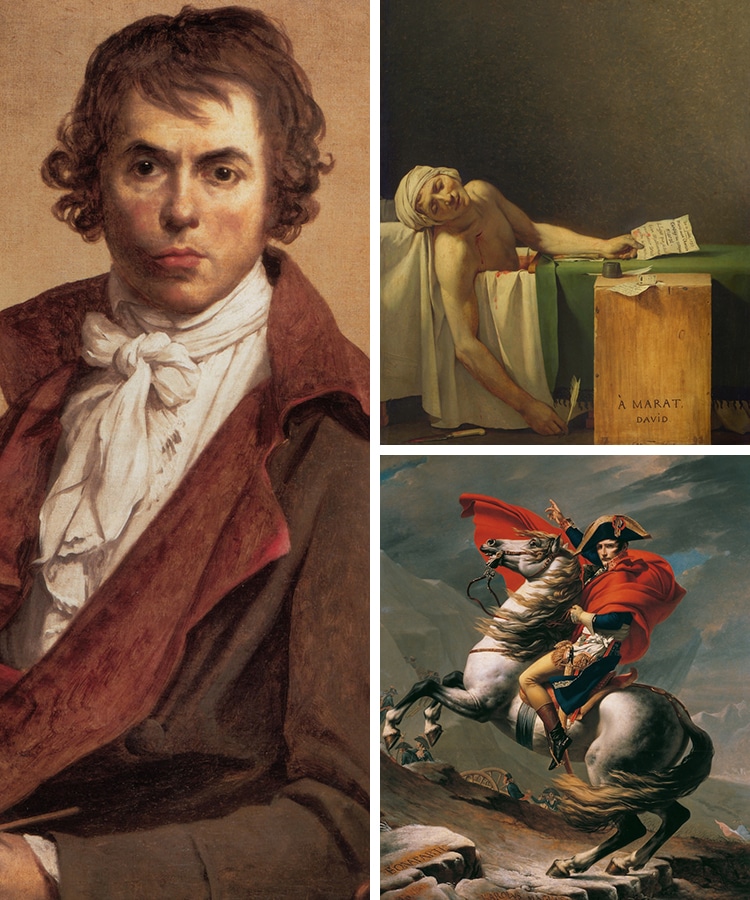
Art is often referred to as a reflection of society and culture. Looking at famous paintings and sculptures from the past can help us understand significant historic events and the circumstances surrounding them. During the late 18th and early 19th centuries, French artist Jacques-Louis David captured the political turmoil of France, from the French Revolution to the rise and fall of Napoleon.
Although Rococo was the dominant painting style during David's early years, he rejected its frivolous aesthetic in favor of a style rooted in classical principles and subject matter. Called Neoclassical art, David would use this striking approach in his paintings to romanticize the French Revolution's quest for a republic, and later, Napoleon's transformation into a classical leader of the French empire.
Here, we will learn more about David's life and art.
Full Name | Jacques-Louis David |
Born | August 30, 1748 (Paris, France) |
Died | December 29, 1825 (Brussels, United Kingdom of the Netherlands) |
Notable Artwork | The Oath of the Horatii, Death of Marat |
Movement | Neoclassical |
Who was Jacques-Louis David?
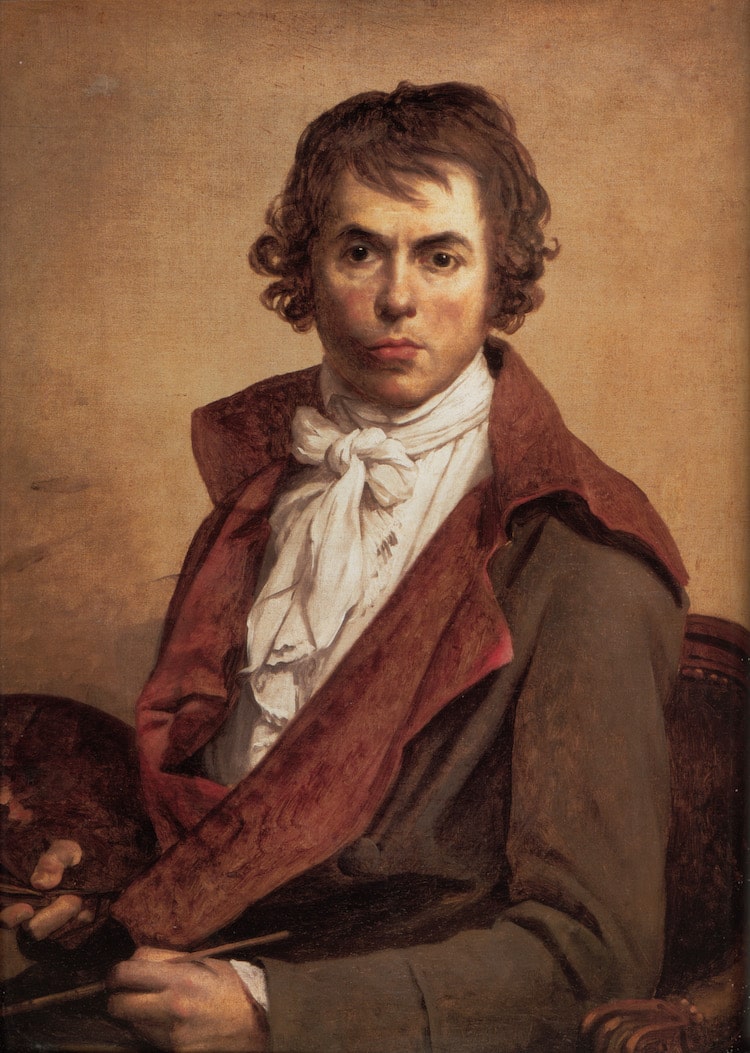
Jacques-Louis David, “Self-Portrait,” 1794 (Photo: Louvre Museum via Wikimedia Commons, Public domain)
Most consider Jacques-Louis David (1748–1825) to be the leading Neoclassical painter of the era. Originally from Paris, he received a robust and well-rounded education in fine art that honed his talents and helped him become a sensation at the Salon.
He produced art that was unlike the Rococo status quo—with few colors, minimalist but balanced compositions, and depictions of classical subject matter. During the French Revolution, he affiliated himself with Maximilien Robespierre and created art that supported his side. Later, when Napoleon rose to power, David realigned himself again and made art in support of the new regime. His art had a far-reaching impact on Neoclassical artists across Europe.
Characteristics of his art include precise draftsmanship, emphasis on symmetry, harmonious compositions, limited color palette, and classical inspirations.
French Revolution
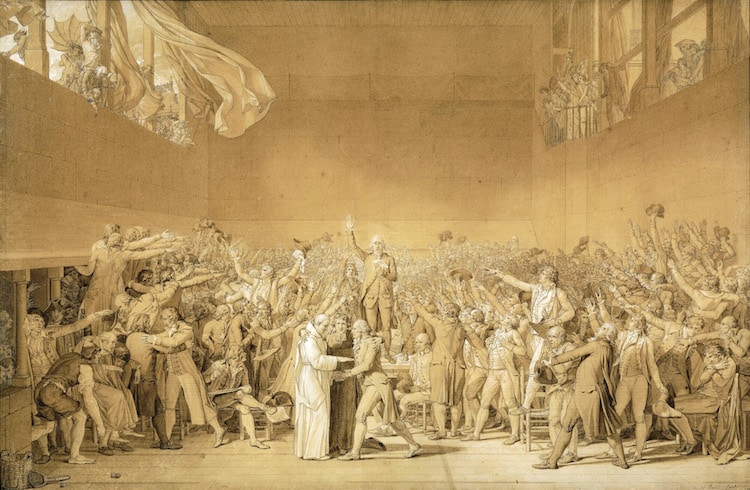
Jacques-Louis David, Drawing of the Tennis Court Oath, 1791 (Photo: Palace of Versailles via Wikimedia Commons, Public domain)
Although David had worked under the patronage of the king of France—an enviable and profitable position for an artist of this time—he was an ardent supporter of the French Revolution. His interest in Ancient Rome and republican ideals likely spurred his participation in the revolution. During this time, he created many of his most iconic Neoclassical pieces, including the Oath of the Horatii.
David was a friend of Robespierre and Jean-Paul Marat—two major figures of the French Revolution—and voted in favor of executing Louis XVI. After Marat was killed by a Girondins-sympathizer named Charlotte Corday, David set to work on his masterpiece entitled The Death of Marat. In this painting, he immortalized, and in many ways idealized, Marat's role as a writer and martyr of the Republic.
After Robespierre was arrested at the National Convention in July 1794, David was also imprisoned at the Palace of Luxembourg for his involvement in the revolution. However, he fell ill in the night, which prevented him from being guillotined with Robespierre the next day. Instead, he remained in jail until his release in 1796.
Working Under Napoleon

Jacques-Louis David, “The Intervention of the Sabine Women,” 1799 (Photo: Louvre Museum via Wikimedia Commons, Public domain)
After the Reign of Terror was over and David was imprisoned at the Luxembourg Palace, his wife visited him in jail. This interaction became the inspiration for his next painting, The Intervention of the Sabine Women—a classical piece that depicts the Sabine women trying to stop the fight between the Romans and the Sabines. After he was released in 1796, he returned to his studio and completed this piece, which caught the attention of Napoleon.
David was impressed with Napoleon and realigned himself on the side of the French military leader. After Napoleon became the First Consul of France, he commissioned David to make a portrait. The resulting iconic image features Napoleon seated on a white stallion crossing the Alps.
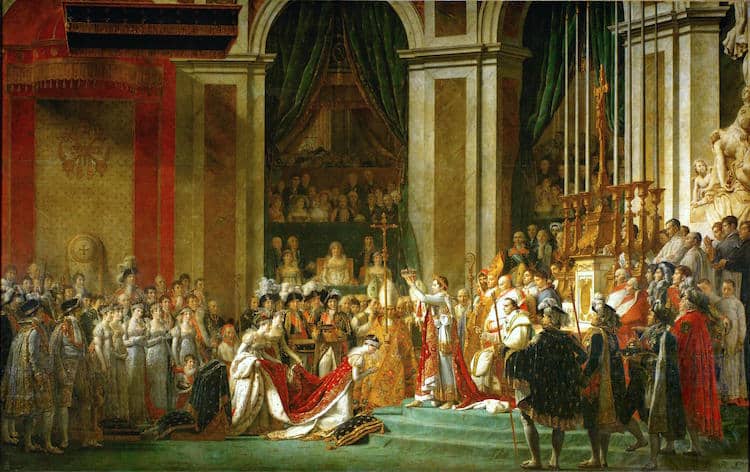
Jacques-Louis David, “The Coronation of Napoleon,” 1805–1807 (Photo: Louvre Museum via Wikimedia Commons, Public domain)
David was made the official court painter of the new regime and created the large-scale painting titled The Coronation of Napoleon, celebrating Napoleon's rise to power.
Famous Paintings
The Oath of the Horatii, 1784–1785
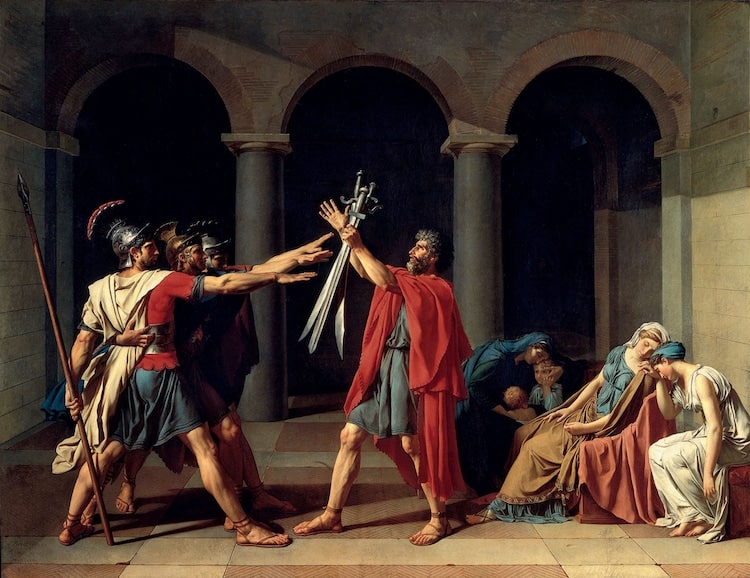
Jacques-Louis David, “The Oath of the Horatii,” 1784–1785 (Photo: Wikimedia Commons, Public domain)
Title | The Oath of the Horatii |
Artist | Jacques-Louis David |
Year | 1784–1785 |
Medium | Oil on canvas |
Size | 129.8 in × 167.2 in (329.8 cm × 424.8 cm) |
Location | Louvre (Paris, France) |
Created between 1784 and 1785, The Oath of the Horatii embodies the ideals of Neoclassical painting. It depicts the legendary Roman Horatii brothers as they pledge to fight the three Curiatii brothers from Alba Longa to protect Rome and end the war between the two cities.
David portrays this patriotic narrative with a limited austere color palette, dominated by reds and some blue. Additionally, he creates a harmonious composition that resembles the balance and clarity of a scene on stage. Furthermore, he employs precise draftsmanship with bold, strong lines, and minimal ornamentation.
Death of Marat, 1793
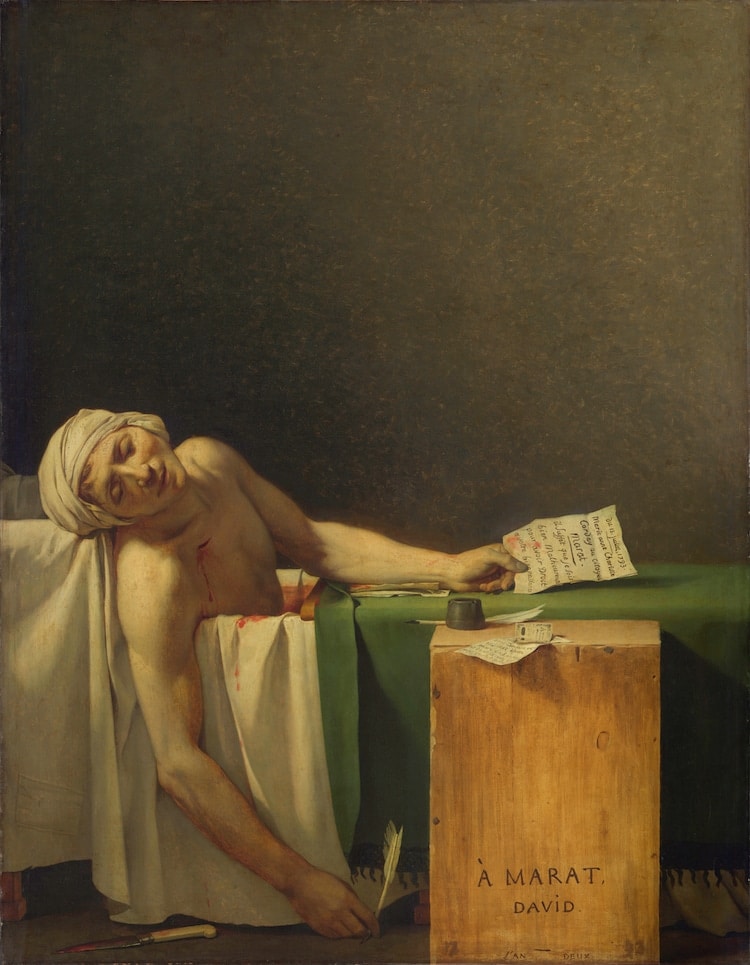
Jacques-Louis David, “The Death of Marat,” 1793 (Photo: Wikimedia Commons, Public domain)
Title | Death of Marat |
Artist | Jacques-Louis David |
Year | 1793 |
Medium | Oil on canvas |
Size | 64 in × 50 in (162 cm × 128 cm) |
Location | Royal Museums of Fine Arts of Belgium (Brussels, Belgium) |
David completed The Death of the Marat in his signature Neoclassical style. The piece depicts Jean-Paul Marat—a radical political theorist and a key figure of the French Revolution—moments after his murder, as he is shown slumped over his blood-soaked bathtub with a quill still in hand.
Like other Neoclassical paintings by David, The Death of the Marat features a perfectly balanced composition; Marat and his bathtub form a horizontal plane in the foreground, which offsets the scene's minimalist backdrop. This arrangement culminates in a theatrical scene reminiscent of a stage production, as a literal spotlight illuminates the main character and a selection of strategically placed props, including his freshly-written list and the bloodied murder weapon, which rests on the floor.
David also opted to glamorize Marat himself, foregoing a realistic rendering of his visible dermatitis for a glimpse of the blemish-free skin. Along with Marat's Pietà-like positioning, this strategic decision depicts Marat as a flawless martyr.
Napoleon Crossing the Alps, 1801–1805
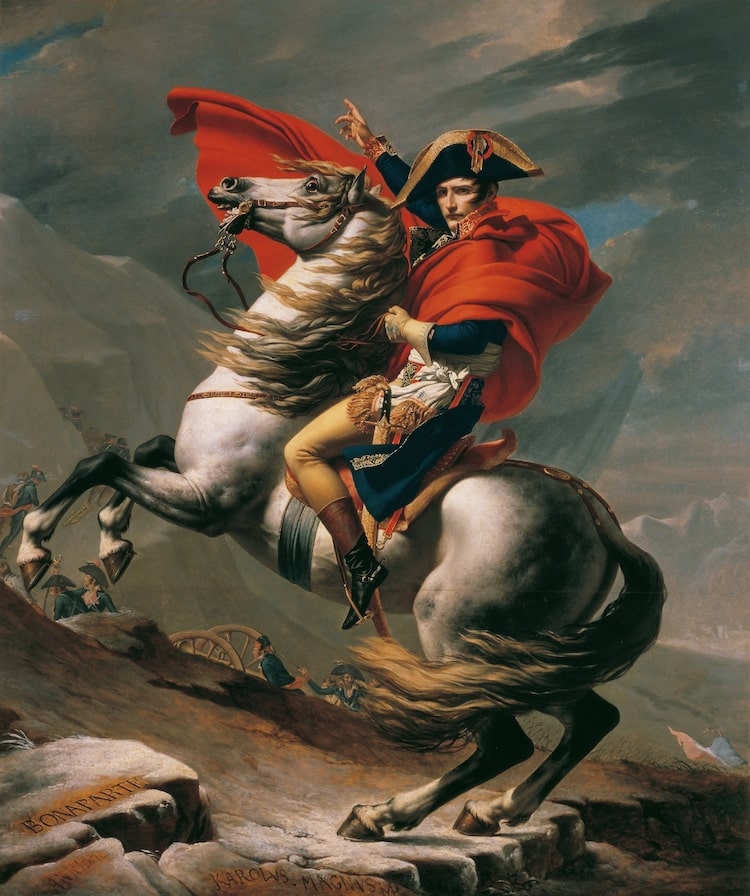
Jacques-Louis David, “Napoleon Crossing the Alps,” Version 2, 1801–1805 (Photo: Belvedere via Wikimedia Commons, Public domain)
Title | Napoleon Crossing the Alps |
Artist | Jacques-Louis David |
Year | 1801 (pictured version) |
Medium | Oil on canvas |
Size | 64 in × 50 in (162 cm × 128 cm) |
Location | 108.2 in x 91.3 in (275 cm x 232 cm) (pictured version) |
When Napoleon rose to power, David aligned himself with the ruler of France and made art in support of the new regime. His equestrian portrait Napoleon Crossing the Alps has become the best-known image of Napoleon, portraying the emperor as he leads his army through the Great St. Bernard Pass.
David made five versions of this portrait between 1801–1805, with minor differences between them. The first version featured Napoleon wearing an ochre-colored cape, whereas all of the subsequent versions depict him wrapped in a red cape.
Later Life and Legacy
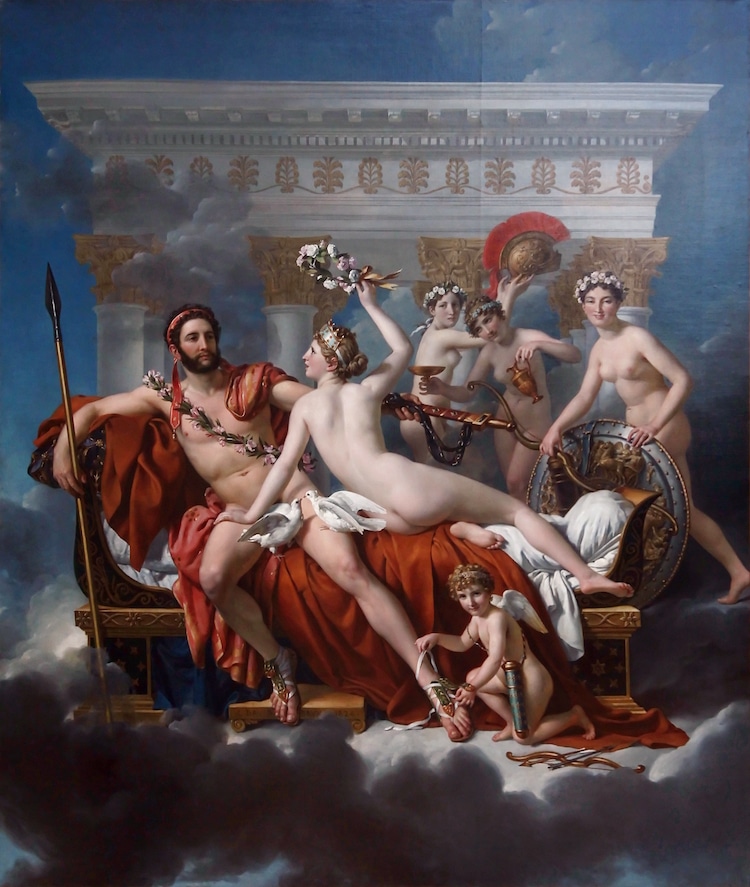
Jacques-Louis David, “Mars Being Disarmed by Venus,” 1822–1824 (Photo: Louvre Museum via Wikimedia Commons, Public domain)
After Louis XVIII was installed as the new king of France, David declined an offer to become court painter and exiled himself to Brussels, Belgium. The remainder of his years were spent working in his studio and teaching Brusself-based artists like François-Joseph Navez and Ignace Brice. Mars Being Disarmed by Benus and the Three Graces was his last major work, which he completed before his death in 1825.
David's prolific career left a lasting impact on Western art history. Not only did he spearhead the Neoclassical style, but he also became an integral part of French history with his depictions of the French Revolution and Napoleon. In addition, David was a teacher to many great artists, including Antoine-Jean Gros and Jean-Auguste-Dominique Ingres.
Frequently Asked Questions
What was Jacques-Louis David known for?
Jacques-Louis David was known for pioneering the Neoclassical style, portraying significant events from the French Revolution including the death of Jean-Paul Marat, and for his role as the official court painter to Emperor Napoleon.
Why was Jacques-Louis David imprisoned during the French Revolution?
As an active supporter of the French Revolution, Jacques-Louis David was imprisoned soon after Robespierre was seized during the National Convention in July 1794. However, David fell ill in the night and avoided being guillotined with Robespierre and other revolutionaries.
What type of artist was Jacques-Louis David?
Jacques-Louis David was a French Neoclassical painter.
Related Articles:
Monumental Masterpieces: 10 of Art History’s Most Famous Large-Scale Paintings
Here’s Where 20 of Art History’s Most Famous Masterpieces Are Located Right Now
30 Famous Paintings From Western Art History Any Art Lover Should Know






















































































